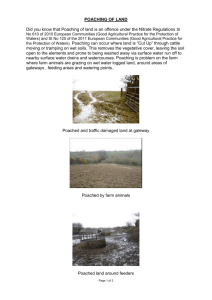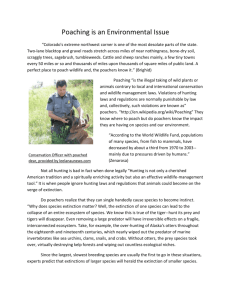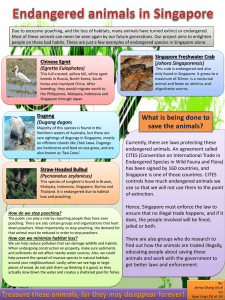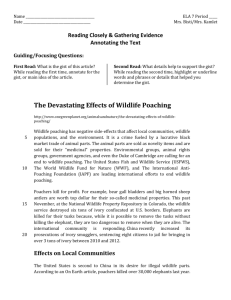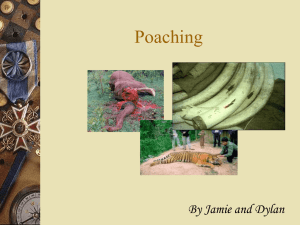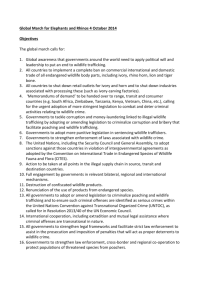Enhancing global efforts to combat poaching and
advertisement
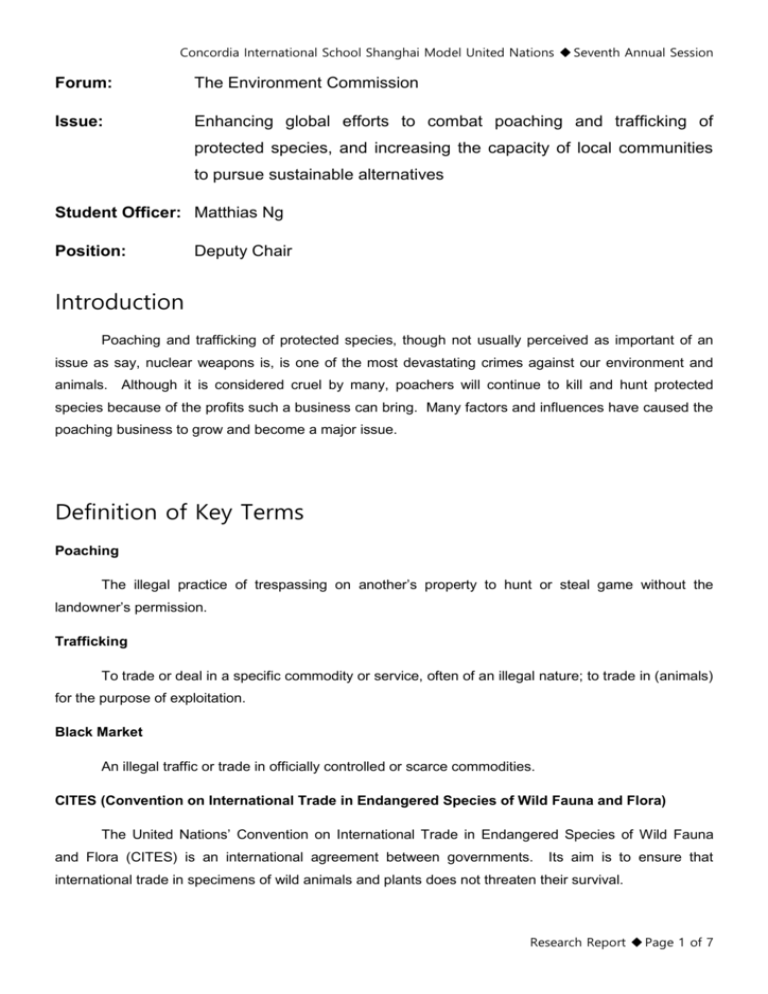
Concordia International School Shanghai Model United Nations ◆ Seventh Annual Session Forum: The Environment Commission Issue: Enhancing global efforts to combat poaching and trafficking of protected species, and increasing the capacity of local communities to pursue sustainable alternatives Student Officer: Matthias Ng Position: Deputy Chair Introduction Poaching and trafficking of protected species, though not usually perceived as important of an issue as say, nuclear weapons is, is one of the most devastating crimes against our environment and animals. Although it is considered cruel by many, poachers will continue to kill and hunt protected species because of the profits such a business can bring. Many factors and influences have caused the poaching business to grow and become a major issue. Definition of Key Terms Poaching The illegal practice of trespassing on another’s property to hunt or steal game without the landowner’s permission. Trafficking To trade or deal in a specific commodity or service, often of an illegal nature; to trade in (animals) for the purpose of exploitation. Black Market An illegal traffic or trade in officially controlled or scarce commodities. CITES (Convention on International Trade in Endangered Species of Wild Fauna and Flora) The United Nations’ Convention on International Trade in Endangered Species of Wild Fauna and Flora (CITES) is an international agreement between governments. Its aim is to ensure that international trade in specimens of wild animals and plants does not threaten their survival. Research Report ◆ Page 1 of 7 Concordia International School Shanghai Model United Nations ◆ Seventh Annual Session IUCN (International Union for Conservation of Nature) The International Union for Conservation of Nature (IUCN) is an international organization working for nature conservation and sustainable use of natural resources. It’s mission is to “Influence, encourage and assist societies throughout the world to conserve nature and to ensure that any use of natural resources is equitable and ecologically sustainable.” History Poaching until the 17th century Prior to the 17th century, people poached animals either for need or greed. Some people poached for their survival because they had no food, while others poached animals for the purpose of selling them on the black market to earn money. Poaching until the 20th century Elephant Ivory is first discovered, and demand rapidly rises as elephant populations begin to decline. Ivory is used to make piano keys, billiard balls, sculptures, and other luxury goods. Poaching in the 20th century Approaching the later part of the 20th century, elephant numbers drop from 1.2 million to around 600,000. Rhinos and tigers are also hunted for animal products. Rapidly advancing technology and increasing demand from regions such as Asia help facilitate poaching and trafficking, resulting in the growth of this industry. CITES is formed as an attempt to combat the rising issue of poaching and to protect species that are targeted by poaching. The poaching industry was soon brought to international attention in the 1990s. Poaching in the 21th century and onwards Unfortunately, poaching and trafficking of protected species is still prominent in most countries in Africa, and many species such including zebras, elephants, tigers, and rhinos are becoming extremely endangered in the wild. Research Report ◆ Page 2 of 7 Concordia International School Shanghai Model United Nations ◆ Seventh Annual Session Caption #1: A baby elephant with its mother whose tusks have been sawed off from poaching. Key Issues Poverty Poverty is often thought of as one of the main factors for driving people into the poaching business. It is sometimes the case that poorer people will engage in poaching to earn money; therefore solving poverty is both a direct and indirect solution to conservation. Demand In most cases, demand for animal products, especially in Asia, that drives the poaching and trafficking economy. A quote from a research report conducted by Prof. Rosaleen Duffy reads, “The demand for ivory has surged to the point that the tusks of a single adult elephant can be worth more than 10 times the average annual income in many African countries.” This makes it quite clear that demand is a major factor that drives poaching. Corruption In many countries where poaching and trafficking are rampant, government officials and upper class members are often engaged in the poaching industry rather than trying to combat it, therefore letting poaching and trafficking of protected species be present without many consequences. In addition, although poachers are often caught, it still leaves the people that are responsible and their networks safe. Discouraging poaching and trafficking Even if governments start cracking down on poachers, they will not be able to remove the demand for animal products. In order to truly solve this issue, governments must find a way to discourage people from engaging in poaching because no demand leads to fewer animals being poached. Sustainable alternatives Research Report ◆ Page 3 of 7 Concordia International School Shanghai Model United Nations ◆ Seventh Annual Session In addition to solving this issue from the source, finding sustainable alternatives for local communities is also an important step forward. Some possible alternatives include providing training and equipment for local community members to pursue eco-tourism, bee-keeping, and sustainable farming. Major Parties Involved and Their Views The United Nations/ Wildlife Conservation Groups/ MEDCs The United Nations, wildlife conservation groups, and MEDCs obviously condemn this practice because of its effects on biodiversity and illegal killing of animals. LEDCs These countries are divided when it comes to this issue – for one, poaching and trafficking of animals is immoral and are illegal, but on the other hand, it generates revenue through black market trading and is often an important part of the country’s economic growth. Other LEDCs These countries are probably against poaching and trafficking of animals as well, because it does not generate revenue for the country. Timeline of Relevant Resolutions, Treaties and Events Date Description of event The Convention on International Trade in Endangered Species of Wild Fauna March 3, 1973 and Flora (CITES) was signed as a multilateral treaty to protect endangered plants and animals. The Endangered Species Act is signed into law by President Richard Nixon, December 28, 1973 which is designed to take the necessary steps toward protecting critically endangered species from extinction. The United Nations General Assembly publishes a draft resolution on Tackling July 15, 2015 Illicit Trafficking in Wildlife, encouraging all nation states to take action in addressing this issue. The topic of combating poaching and trafficking of protected species, as well as September 26, 2015 helping local communities pursue more sustainable alternatives, was brought up during the UN Sustainable Development Summit this year, and are addressed in Research Report ◆ Page 4 of 7 Concordia International School Shanghai Model United Nations ◆ Seventh Annual Session goals 1, 12, 14, 15, 16, and 17. Evaluation of Previous Attempts to Resolve the Issue There have been multiple previous attempts at resolving the issue of poaching and trafficking of protected species. The first ever attempt at wildlife conservation and combatting the issue of poaching was CITES. CITES was able to rally almost all countries in the world to start the fight against poaching and trafficking. Since 1973, CITES has been able to slowly improve the situation for many endangered species. Although somewhat successful, CITES has had some shortcomings as well. In many cases, by design and intent, it focuses on trade at the species level and does not address habitat loss, ecosystem approaches to conservation, and poverty. One other significant attempt at solving this issue was when Richard Leakey, former director of the Kenya Wildlife Service, managed to convince the present of Kenya to burn the country’s stockpile of accumulated ivory in 1989. This attempt rallied the world, resulting in ivory trade to be banned globally within a year, and helped elephant populations rise back to about 1 million in the next 10 years. Sadly, demand pressure from South African and Asian countries forced CITES to allow the sanctioning of a legal trade of tusks in 1999. Since then, there have been no more significant attempts to resolve the issue of poaching. Possible Solutions Some possible solutions include: - Having countries take decisive steps by strengthening legislation to stop illegal wildlife trade on both supply and demand sides - Improving the criminal arrestment and prosecution of illicit poaching and trafficking in wildlife - The respective Ministries of Wildlife Conservation must be able to state some basic codes to follow as well as provide incentives for local populations to protect endangered species - Standardizing information gathering efforts in order to find out about the true magnitude of the problem - Awareness programs in order to bring the issue to the attention of the public, as well as inform local communities about the devastating effects of species going extinct and poaching practices - Addressing the actual root cause of the problem (poverty, corruption, etc.) Research Report ◆ Page 5 of 7 Concordia International School Shanghai Model United Nations ◆ Seventh Annual Session Bibliography "Alternative Livelihoods For Ex Poachers, Kenya." Global Giving. N.p., n.d. Web. <https://www.globalgiving.org/projects/ex-poachers-kenya/>. "Amid 'steady Rise' in Rhino Poaching and Elephant Killings, UN Urges Action to Tackle Illegal Wildlife Trade." UN News Center. UN, 30 July 2015. Web. 10 Nov. 2015. <http://www.un.org/apps/news/story.asp?NewsID=51536#.VjrCjmQrIfF>. "CITES." Wikipedia. N.p., n.d. Web. <https://en.wikipedia.org/wiki/CITES>. "The Devastating Effects of Wildlife Poaching." One Green Planet. N.p., n.d. Web. <http://www.onegreenplanet.org/animalsandnature/the-devastating-effects-of-wildlife-poaching/>. Duffy, Rosaleen, Prof., and Freya A. V. St John, Dr. "Poverty, Poaching , and Trafficking: What Are the Links?" Evidence on Demand. N.p., n.d. Web. <http://eprints.soas.ac.uk/17836/1/EoD_HD059_Jun2013_Poverty_Poaching.pdf>. Express.co.uk. N.p., n.d. Web. <http://cdn.images.express.co.uk/img/dynamic/128/590x/ElephantsGETTY-440672.jpg>. Froelich, Amanda. "Innovative Organization Turns African Poachers Into Sustainable Farmers." True Activist. N.p., 20 June 2015. Web. 10 Nov. 2015. <http://www.trueactivist.com/innovativeorganization-turns-african-poachers-into-sustainable-farmers/>. "The History of the Ivory Trade." National Geographic Education. N.p., 15 Feb. 2013. Web. 10 Nov. 2015. <http://education.nationalgeographic.com/media/history-ivory-trade/>. "Illegal Wildlife Trade." Wildlife Conservation Society. N.p., n.d. Web. <http://www.wcs.org/ourwork/solutions/illegal-wildlife-trade>. "Illegal Wildlife Trade." World Wildlife. N.p., n.d. Web. <http://www.worldwildlife.org/threats/illegalwildlife-trade>. "International Union for Conservation of Nature." Wikipedia. N.p., n.d. Web. <https://en.wikipedia.org/wiki/International_Union_for_Conservation_of_Nature>. Joseph, Jamie. "UN Helen Clark: The Poverty Link to the Poaching Crisis." Saving the Wild. N.p., n.d. Web. <http://www.savingthewild.com/2014/07/un-helen-clark-rural-poverty-is-fuelling-thepoaching-crisis/>. Research Report ◆ Page 6 of 7 Concordia International School Shanghai Model United Nations ◆ Seventh Annual Session "New UN Guidelines Issued to Counter ‘critically High’ Levels of Elephant Poaching in Africa." UN News Center. UN, 13 Nov. 2014. Web. 10 Nov. 2015. <http://www.un.org/apps/news/story.asp?NewsID=49334#.VkIARGQrIfG>. "New UN-backed Report Finds ‘alarmingly High’ Levels of Elephant Poaching across Africa." UN News Center. UN, 13 June 2014. Web. 10 Nov. 2015. <http://www.un.org/apps/news/story.asp?NewsID=48043#.VkIARGQrIfG>. "Poaching." Wikipedia. N.p., n.d. Web. <https://en.wikipedia.org/wiki/Poaching>. "Richard Leakey." Wikipedia. N.p., n.d. Web. <https://en.wikipedia.org/wiki/Richard_Leakey>. "SDGs & Topics .:. Sustainable Development Knowledge Platform." SDGs & Topics .:. Sustainable Development Knowledge Platform. N.p., n.d. Web. 10 Nov. 2015. <https://sustainabledevelopment.un.org/topics>. "Tackling Illicit Trafficking in Wildlife." UN. UN, 15 July 2015. Web. 10 Nov. 2015. <http://daccess-ddsny.un.org/doc/UNDOC/GEN/N15/221/20/PDF/N1522120.pdf?OpenElement>. "Timeline: A History of Poaching and Protecting Wildlife." N.p., n.d. Web. <http://blogs.uoregon.edu/cgsf13gateway/timeline/>. "UN Security Council Targets Poaching and Wildlife Trade with DRC Sanctions." WWF. WWF, 30 Jan. 2014. Web. 10 Nov. 2015. <http://wwf.panda.org/?214971%2FUN-Security-Council-TargetsPoaching-and-Wildlife-Trade-with-DRC-Sanctions>. Yuan, Liu. "CITES Secretariat Welcomes Adoption of United Nations Sustainable Development Goals with Specific Targets to End Poaching and Trafficking of Wildlife." CITES. N.p., n.d. Web. <https://cites.org/eng/CITES_welcomes_UN_SDGs_with_target_to_end_poaching_trafficking_wil dlife_25092015>. Research Report ◆ Page 7 of 7
